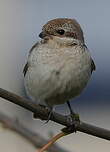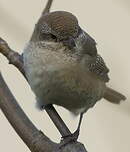Red-tailed Shrike
Lanius phoenicuroides - Pie-grièche du Turkestan
Identification
Not long ago, the Red-tailed Shrike of Turkestan, also known as the Red-tailed Shrike, was a subspecies of the Isabelline Shrike (Lanius isabellinus). Currently, it is considered a good species by the International Ornithological Committee, Lanius phoenicuroides. That is why it has a gallery on oiseaux.net.
Distinguishing the different taxa from the former superspecies L. isabellinus is not easy as they are very similar from all points of view. Their distribution and the location of the observation are criteria to be taken into account before any identification. The description here will be made in reference to the description of the Isabelline Shrike given elsewhere in order to avoid repetition. The two taxa are very similar in terms of silhouette and behavior.
The adult male can be recognized by the greater contrast between the top and the bottom. The upper parts are of a relatively dark bru-beige, with a clear reddish hue on the head. The rump, the tertials and the tail are of a deeper red, with a brown hue on the central rectrices and at the end of the others. So the top of the body is generally less uniform. Generally, a sharp white eyebrow slips between the russet cap and the black mask. The lower parts are paler, less infiltrated by red, and often appear white from afar. A salmon hue is often distinguished when the plumage is new. The white spot of the primaries stands out well on the dark brown background of the wing. But be careful of the ambient light that can change the perception of colors. In addition, some individuals appear intermediate, with a grayer upper part, less red and a weakened eyebrow. Great vigilance is always necessary for such individuals.The female resembles the male, but with less distinct and contrasting colors, and a less noticeable eyebrow. The rest can be repeated of what has been said for the female isabelle, as well as for the juvenile individual. This species is said to hybridize in the west of its range with the Red-tailed Shrike with which it comes into contact in the east and south of the Caspian Sea. The hybrids produced are intermediate, with a much darker tail, possibly blackish, and a very reduced white patch on the primaries.
Subspecific information monotypic species
Foreign names
- Pie-grièche du Turkestan,
- Alcaudón colirrojo,
- picanço-do-turquestão,
- Rotschwanzwürger,
- Turkestaanse Klauwier,
- Averla codirossa,
- turkestantörnskata,
- Rødhalevarsler,
- strakoš turkménsky,
- ťuhýk turkestánský,
- Turkestantornskade,
- ruostepäälepinkäinen,
- Rooistertlaksman,
- dzierzba rdzawosterna,
- rudastes čakste,
- Туркестанский жулан,
- アカオモズ,
- 棕尾伯劳,
- turkestantörnskata,
- 棕紅尾伯勞,
Habitat
The habitat varies according to the country and the latitude. For example, in Pakistan, the Red-tailed Shrike nests at altitudes above 2000 m, in low shrub vegetation based on junipers. On the other hand, in the south of Turkmenistan, it is a bird of the plain, nesting in tamarisk valleys, the bushes of the steppe, the reed beds around water courses and even in agricultural areas such as pistachio plantations.
Reproduction nesting
The Red-tailed Shrike of Turkestan nests in bushes, particularly spiny bushes, like the Hooded Crow. The nest is built at an average height of one meter, sometimes higher in pistachio trees or aspens up to 3-5 m.
The nest resembles that of the Hooded Crow. When built in reed beds, like around Lake Balkhash, it can be entirely made of elements taken from the immediate environment (leaves, fibers, inflorescences of reeds). The female lays 3 to 7 eggs, on average 5, which is a slightly higher clutch size than Isabellinus. The nest is frequently parasitized by the Eurasian Grey Cuckoo. For example, at the edge of Lake Balkhash, 13 parasitized nests were found out of 90 checked nests.Geographic range
The Red-tailed Shrike of Turkestan breeds in the west and southwest range of the Lesser Grey Shrike, from Iran to Chinese Xinjiang, through countries of Central Asia and Kazakhstan to the north, western Pakistan and Afghanistan to the south.
The winter range is separate. This shrike will winter in the African continent, mainly in the northeast, Ethiopia, Sudan, Uganda, Kenya and Tanzania, and further west, Chad, Niger and Nigeria. Some individuals might even reach the Atlantic coast in the Gambia, Mali and Mauritania. On their way they pass across the Arabian Peninsula where they can stay a bit longer.
Threats - protection
Sources of information
- IOC World Bird List (v14.2), Gill, F and D Donsker (Eds). 2024-04-18.
- HBW Alive,
- Avibase, Lepage Denis
- SHRIKES A Guide to the Shrikes of the World, Lefranc Norbert, Worfolk Tim
Other sources of interest
 Specification sheet created on
27/07/2023 by Jean François
Specification sheet created on
27/07/2023 by Jean FrançoisTranslation by AI Oiseaux.net
© 1996-2025 Oiseaux.net
- Accipitriformes
- Aegotheliformes
- Anseriformes
- Apodiformes
- Apterygiformes
- Bucerotiformes
- Caprimulgiformes
- Cariamiformes
- Casuariiformes
- Charadriiformes
- Ciconiiformes
- Coliiformes
- Columbiformes
- Coraciiformes
- Cuculiformes
- Eurypygiformes
- Falconiformes
- Galliformes
- Gaviiformes
- Gruiformes
- Leptosomiformes
- Mesitornithiformes
- Musophagiformes
- Nyctibiiformes
- Opisthocomiformes
- Otidiformes
- Passeriformes
- Pelecaniformes
- Phaethontiformes
- Phoenicopteriformes
- Piciformes
- Podargiformes
- Podicipediformes
- Procellariiformes
- Psittaciformes
- Pterocliformes
- Rheiformes
- Sphenisciformes
- Steatornithiformes
- Strigiformes
- Struthioniformes
- Suliformes
- Tinamiformes
- Trogoniformes




























